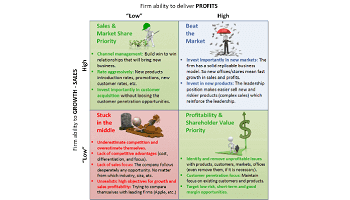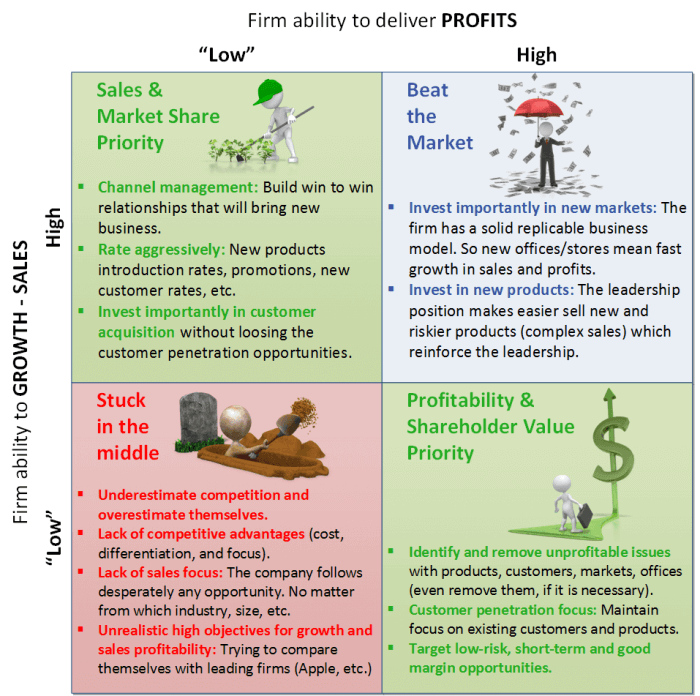- November 7, 2015
- Posted by: Javier González Montané
- Categories: Sales, Strategy, Turnaround

There are some firms that oversimplified the process to build and analyze the company’s growth strategy. Those companies used to confuse the growth strategy with the growth objectives. Thus, they define the Sales Gross Profit Ratio that they would like to achieve, and they also assign the growth quota to each Sales Rep. Unfortunately, growing is not as easy as define the Sales Gross Profit Ratio, and other sales growth objectives according to the company Strategic Plan.
Other organizations confuse growth strategy with growth tactics. So, they oversimplified again the growth strategy assuming that growth strategy is just defining the new markets, new products and new customers that the company would like to enter.
The four main growth strategies
In order to define our growth strategy, we should consider two variables: sales and profitability. Then, we can get the four main growth strategies according to a high or low growth ability in sales and profits.
Growth Strategy Matrix: Growth tatics for each strategic choice

1. Beat the market: This is the objective of many firms. You have likely heard comments like “we need very profitable sales growth.” However, beating the market as Zara/Inditex is doing in the apparel business quarter by quarter is not an easy task. This leader firm increases revenue consistently higher than inflation and its main competitors, and its net profit grows much faster than sales. Organizations beating the market need to have a solid and replicable business model. Thus, they can growth fast at the same time that they manage very efficient assets, expenses and financing costs.
2. “Stuck in the middle”: In reality this is not a growing strategy rather than a consequence of the failure to implment “beat the market” strategy. This situation happens when organizations are trying to maximize at the same time sales growth and profitability when they do not have a very good and sustainable business model yet. In these organizations, Sales Reps are pushed to quote higher than customers are willing to pay for the perceived quality of their products and services. This situation makes sales growth very low or even negative growth. The sales force gets demotivated because they cannot see any progress, and their bonus and even their jobs get in danger. The cost of sales compared with sales volume is raising and affecting to profitability. The low profitability will affect the self-finance and the future competitiveness of the products and services.
Nokia and Blackberry are two examples of companies that tried to imitate Apple iPhone beating strategy based on hardware plus software in order to growth importantly sales and profits. The consequences have been terrific for both companies. If they had chosen a more conservative and realistic growth strategy, just trying to maximize sales and market share focusing on mobile devices and using Google Android as software platform… Do you think that they would have still lost the important market share from competitors like Samsung or LG? Do you think that this more focused growth strategy would have worked better for them?
Many people sell us the idea that we have to build very innovative firms like some market leaders (Apple and so on). Nevertheless, many times they are missing explaining the consequences of a failure pursuing a market leader strategy especially when they try to lock the market like Apple (creating his ecosystem).
3. Profitability and shareholder value priority: Organizations following this strategy have learnt that more sales do not necessarily mean more profitability and shareholder value. One example was Daimler disinvestment in Chrysler. First, Daimler invested in Chrysler expecting important synergies between both companies but synergies were not materialized. So the company grew in total sales but the new merged company was less profitable compared with the total investment, and less attractive for shareholders. So the focus on profitability support decisions of avoiding and even divesting in some markets, business segments, products, and even some customers.
4. Sales and market share priority: These companies understand that they are not market leaders and customers still have some problems to perceive the company cost or differentiation competitive advantage. So they also understand that strategy is about managing tradeoffs, and most of the time there is a tradeoff between sales and profitability growth. One common tactic to growth faster used to be reduce rates and show more economic value to customers. This tactic is a direct attack to market leaders who used to take advantage of their leadership position to get higher margins.
We have to highlight that growth strategy must be adapt to the context of the organization. For instance, the Spanish oil and gas operator Repsol used to have a sales priority when the crude oil barrel price was higher than USD 100. Nevertheless, for 2015 new Strategic Plan, (at the end of 2015 the crude oil barrel price is around USD 50) they have decided to implement a new growth strategy based on profitability growth (waiting for better crude oil prices to change again the growth strategy to sales priority).
Basically, we can say that a common mistake used to be assuming that all the companies and with independence of the market and company situation can materialize high profitable growth of sales. Most success companies realize that there is a tradeoff between growth sales and profitability, and they decide to prioritize one of these two strategies.
Failing to implement the growth strategy creates some situations which demand an urgent turnaround
“Stuck in the middle” as I have explained is not a strategy rather than the consequence of failure to trying to “Beat the market.”
In the case of failing to pursue the profitability priority, the commonest risk could call being “Kicked out of the market.” I mean sometimes an excess focus on profitability (ROI and ROA) could push companies to focus too much in short-term. Even if the priority is profitability, long-term growth should be in mind to guarantee the long-term survival of the firm.
For sales growth priority, we have to analyze in more detail a few critical situations when the sales growth strategy is not well implemented:
- “Death of success.” The organization does not realize that for most companies (unless you have negative working capital days) growing sales means extra financing needs in order to finance new stock and DSO (Days of Sales Outstanding). So, firms face lack of self-finance because the business grow too fast. The company has to go for external finance what make financing cost very high and unsustainable.
- “Death spiral.” Too fast growth and/or low capital when we are growing up in new opportunities. The fast growth and/or low capital make a weak and unsustainable growth strategy. In order to support the “New Children” (Boston Consulting Group Growth Matrix), we remove resources from the “Cows” business. If we remove too much cash, the consequences are very dangerous for all Business Units. “Cows” lost competitiveness very fast because the exit of cash reduces their purchasing power. Additionally, Directors taken those decisions used to try to take maximum advantage of the well-established Business Units (“Cows”) to maximize DPO (Days of Purchasing Outstanding) which used to erode even more the credibility in front of Suppliers. Suppliers start reducing quality because they prioritize the orders from other customers who pay better. The company lost the option to have better future payment terms in case that the business will face cash issues. The business units are interconnected, I mean “Children” need the cash from “Cows” to survive. So, any cash flow problem in the “Cows” will be immediately moved to “Children.” The lack of planning of the appropriate amount of cash that could be removed from “Cows” can collapse the whole group of Business Units.
- “Running away to the front.” When the firm has made important investments before materializing the sales. Low profitability of the investment and important finance costs because the self-finance is low can strangle the firm.
- “Self-cheating.” The lack of competitive advantage of the company is solved by selling according to the firm Gross Contribution Ratio rather than Operating Profit Ratio. So overheads are not supported for new sales and even for contract renewals. Contract by contract, and month by month the firm is eroding its profitability with low sales margins.
Growth is not just a company desire. Growth requires a lot of human and financial resources. Without the necessary planned resources, we will have just a false start in our implementation growth plan.
Steps to implement the growth strategy
- What is the context of your organization (External Environment, and Internal Analysis)?
- What is your company and competitors Positioning?
- What are your Products and Services?
- What is your Value Proposition?
- What is your Route To Market (RTM)?
- Define your Growth Strategy (Sales priority, Profitability priority, or Sales & Profitability)?
- Review all the step (move from “what is” questions to “what should be”) according to your Growth Strategy choice.
- Create your plan to implement the new Competencies to develop, Positioning, Products/Services, Value Proposition, and RTM.
Common growth mythic
Growth and profitability depend on hiring a “Sales Guru.” So there are organizations that think what they need to do is contacting with a headhunter to bring a “Sales Guru” from the success market leader. Unfortunately, with the time many firms realize that those “Sales Guru” are not performing as expected. Likely, the main reason is that sales depend heavily on company’s products, and those depend on company’s processes, and those depend on company’s people. So, most of the “Sales Gurus” used to work for well-organized companies that they have been able to build a cost and/or differentiation sustainable competitive advantage. It is quite unprovable that “Sales Gurus” over perform in mediocre firms. Mediocre firms need to reorganize their cost structure and services before trying to revamp sales importantly.
Growth is the responsibility of Sales Department. Growth should be a responsibility of the whole company. Sales Reps in order to properly sell need:
- Well-defined products and services (Marketing responsibility)
- New and better products (Engineering and Product Development responsibility)
- Quality product and services (Quality, Supply Chain and Operations responsibility)
- Cost-efficient processes that make attractively the rates of product and services according to the quality offered it (Supply Chain and
- Operations responsibility)
- Enough cash to pay properly to suppliers and being able to get better rates and services from suppliers (Finance responsibility)
Sales profitability is the responsibility of Sales Department. Sales profitability should be a responsibility of the whole company too.
- Sales Reps in order to achieve a good sales profitability required the following support:
- Well marketing material that supports profitable rates.
- New product and service features that show a good value for money.
- Good customer perception of quality.
- Good processes that allow having low running cost.
- Low finance cost.
- And so on.
Growth leading firms used to have in common that they are excellent almost in all areas of the company. Sales and profitability growth are a responsibility of the whole company and especially of the CEO.

